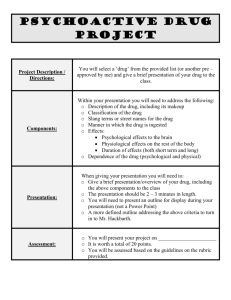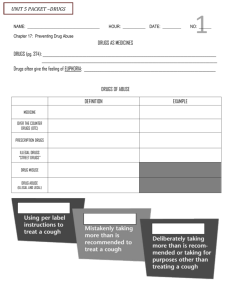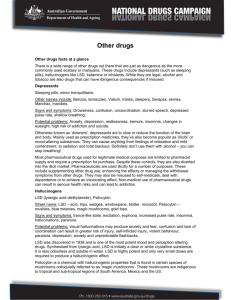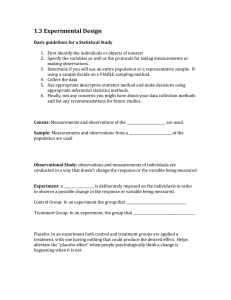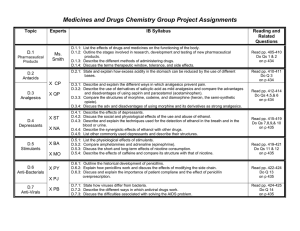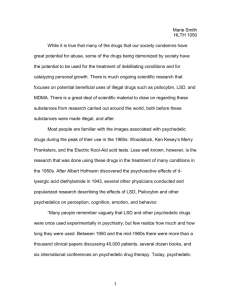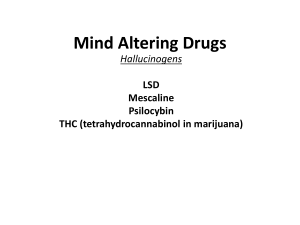Psilocybin Biases Facial Recognition, Goal
advertisement
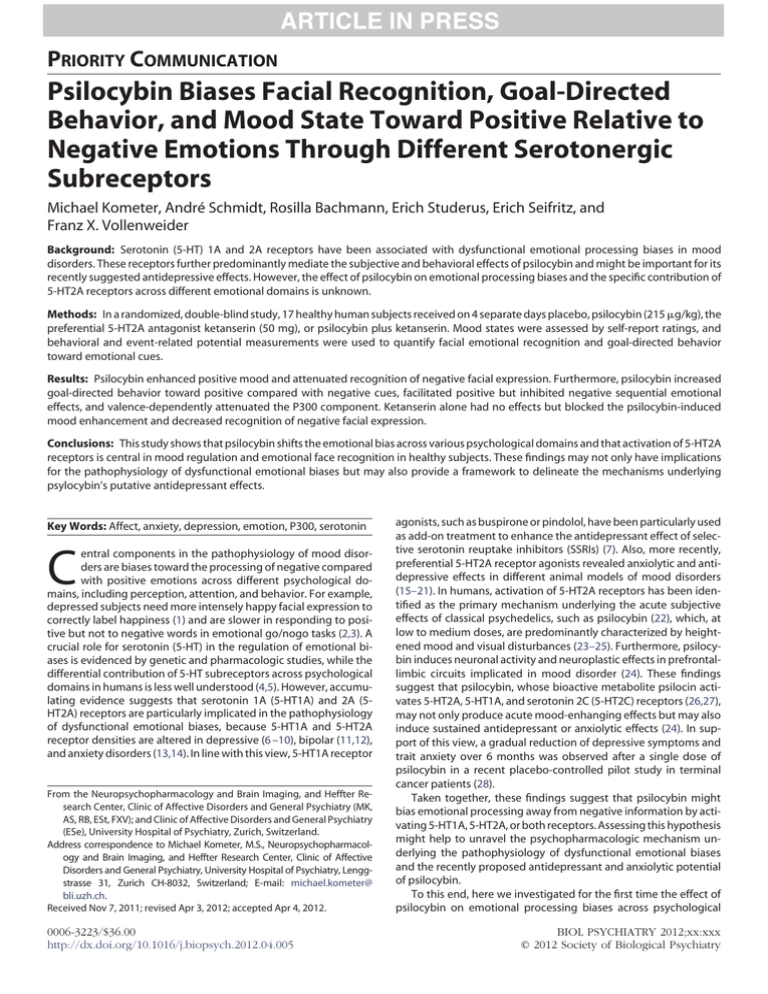
PRIORITY COMMUNICATION Psilocybin Biases Facial Recognition, Goal-Directed Behavior, and Mood State Toward Positive Relative to Negative Emotions Through Different Serotonergic Subreceptors Michael Kometer, André Schmidt, Rosilla Bachmann, Erich Studerus, Erich Seifritz, and Franz X. Vollenweider Background: Serotonin (5-HT) 1A and 2A receptors have been associated with dysfunctional emotional processing biases in mood disorders. These receptors further predominantly mediate the subjective and behavioral effects of psilocybin and might be important for its recently suggested antidepressive effects. However, the effect of psilocybin on emotional processing biases and the specific contribution of 5-HT2A receptors across different emotional domains is unknown. Methods: In a randomized, double-blind study, 17 healthy human subjects received on 4 separate days placebo, psilocybin (215 g/kg), the preferential 5-HT2A antagonist ketanserin (50 mg), or psilocybin plus ketanserin. Mood states were assessed by self-report ratings, and behavioral and event-related potential measurements were used to quantify facial emotional recognition and goal-directed behavior toward emotional cues. Results: Psilocybin enhanced positive mood and attenuated recognition of negative facial expression. Furthermore, psilocybin increased goal-directed behavior toward positive compared with negative cues, facilitated positive but inhibited negative sequential emotional effects, and valence-dependently attenuated the P300 component. Ketanserin alone had no effects but blocked the psilocybin-induced mood enhancement and decreased recognition of negative facial expression. Conclusions: This study shows that psilocybin shifts the emotional bias across various psychological domains and that activation of 5-HT2A receptors is central in mood regulation and emotional face recognition in healthy subjects. These findings may not only have implications for the pathophysiology of dysfunctional emotional biases but may also provide a framework to delineate the mechanisms underlying psylocybin’s putative antidepressant effects. Key Words: Affect, anxiety, depression, emotion, P300, serotonin entral components in the pathophysiology of mood disorders are biases toward the processing of negative compared with positive emotions across different psychological domains, including perception, attention, and behavior. For example, depressed subjects need more intensely happy facial expression to correctly label happiness (1) and are slower in responding to positive but not to negative words in emotional go/nogo tasks (2,3). A crucial role for serotonin (5-HT) in the regulation of emotional biases is evidenced by genetic and pharmacologic studies, while the differential contribution of 5-HT subreceptors across psychological domains in humans is less well understood (4,5). However, accumulating evidence suggests that serotonin 1A (5-HT1A) and 2A (5HT2A) receptors are particularly implicated in the pathophysiology of dysfunctional emotional biases, because 5-HT1A and 5-HT2A receptor densities are altered in depressive (6 –10), bipolar (11,12), and anxiety disorders (13,14). In line with this view, 5-HT1A receptor C From the Neuropsychopharmacology and Brain Imaging, and Heffter Research Center, Clinic of Affective Disorders and General Psychiatry (MK, AS, RB, ESt, FXV); and Clinic of Affective Disorders and General Psychiatry (ESe), University Hospital of Psychiatry, Zurich, Switzerland. Address correspondence to Michael Kometer, M.S., Neuropsychopharmacology and Brain Imaging, and Heffter Research Center, Clinic of Affective Disorders and General Psychiatry, University Hospital of Psychiatry, Lenggstrasse 31, Zurich CH-8032, Switzerland; E-mail: michael.kometer@ bli.uzh.ch. Received Nov 7, 2011; revised Apr 3, 2012; accepted Apr 4, 2012. 0006-3223/$36.00 http://dx.doi.org/10.1016/j.biopsych.2012.04.005 agonists, such as buspirone or pindolol, have been particularly used as add-on treatment to enhance the antidepressant effect of selective serotonin reuptake inhibitors (SSRIs) (7). Also, more recently, preferential 5-HT2A receptor agonists revealed anxiolytic and antidepressive effects in different animal models of mood disorders (15–21). In humans, activation of 5-HT2A receptors has been identified as the primary mechanism underlying the acute subjective effects of classical psychedelics, such as psilocybin (22), which, at low to medium doses, are predominantly characterized by heightened mood and visual disturbances (23–25). Furthermore, psilocybin induces neuronal activity and neuroplastic effects in prefrontallimbic circuits implicated in mood disorder (24). These findings suggest that psilocybin, whose bioactive metabolite psilocin activates 5-HT2A, 5-HT1A, and serotonin 2C (5-HT2C) receptors (26,27), may not only produce acute mood-enhanging effects but may also induce sustained antidepressant or anxiolytic effects (24). In support of this view, a gradual reduction of depressive symptoms and trait anxiety over 6 months was observed after a single dose of psilocybin in a recent placebo-controlled pilot study in terminal cancer patients (28). Taken together, these findings suggest that psilocybin might bias emotional processing away from negative information by activating 5-HT1A, 5-HT2A, or both receptors. Assessing this hypothesis might help to unravel the psychopharmacologic mechanism underlying the pathophysiology of dysfunctional emotional biases and the recently proposed antidepressant and anxiolytic potential of psilocybin. To this end, here we investigated for the first time the effect of psilocybin on emotional processing biases across psychological BIOL PSYCHIATRY 2012;xx:xxx © 2012 Society of Biological Psychiatry 2 BIOL PSYCHIATRY 2012;xx:xxx domains. We also disentangled the specific contribution of the 5-HT2A receptor by antagonizing it with ketanserin. First, we assessed behaviorally the ability to recognize the emotional state of another person from facial cues, which has been previously shown to be biased toward negative emotions in depressed and anxious subjects (1,29 –31) and to be related to serotonergic tone (29 –33). Second, response selection and inhibition to emotional cues were quantified by behavioral and event-related electroencephalogram measurements in an emotional go/nogo task (2). These are crucial components of goal-directed behavior in social environments (34) and are regulated by the 5-HT system (35–37). Finally, we evaluated and quantified acute psilocybin-induced mood effects using clinical relevant rating scales. Methods and Materials Subjects Seventeen healthy, right-handed subjects (11 male subjects, 6 female subjects, mean age 26.0 ⫾ 4.36 years, 15 university students/graduates, 1 high school diploma, 1 apprenticeship) were recruited through advertisement from the University of Zürich. All subjects were healthy according to physical examination, including electrocardiography and detailed blood analysis. The Mini-International Neuropsychiatric Interview for DSM-IV (38), the Expert System for Diagnosing Mental Disorders (39), and the Hopkins Symptom Checklist 90-Revised (40) were used to exclude subjects with present or antecedent psychiatric disorders or a history of major psychiatric disorders in first-degree relatives. The absence of drug dependence or present drug abuse was verified by urine drug screening and a self-report drug use questionnaire. Seven subjects reported having previous experiences with psilocybin or other hallucinogens (mean lifetime experiences 2.4 ⫾ 1.1 times) and three subjects with 3,4-methylenedioxymethamphetamine (MDMA) (mean lifetime experiences 3.3 ⫾ 2.5 times). Eight subjects reported to have rarley or sporadically used cannabis (⬍4 joints per month). Subjects were informed by a written and oral description about the procedures of the study, including that they would receive on each experimental day in a double-blind manner two substances, either placebo ⫹ placebo, placebo ⫹ psilocybin, ketanserin ⫹ placebo, or ketanserin ⫹ psilocybin. Furthermore, they were informed about the possible risk of psilocybin administration and the broad spectrum of its consciousness-altering effects that may range from alterations in sensory perception, mood, thought, and the experience of self. To minimize the influence of the individual’s expectations, we emphasized that the psychological effect of psilocybin is known to vary largely between and within subjects. The study was approved by the ethics committee of the Canton of Zürich. The use of psilocybin in humans was authorized by the Swiss Federal Office of Public Health, Department of Pharmacology and Narcotics, Bern, Switzerland. Experimental Design Using a double-blind, within-subject, placebo-controlled randomized design, subjects received on 4 experimental days, separated from each other by at least 2 weeks, placebo or ketanserin (50 mg) (pretreatment) followed after 1 hour by placebo or psyilocybin (215 g/kg) (treatment). These specific doses were chosen because they have previously been shown to effectively induce or block the associated changes in conscious states, respectively (41). The time delay between pretreatment and treatment was 1 hour to ensure maximal 5-HT2A receptor occupancy. Experiments started approximately 130 minutes after treatment and self-report queswww.sobp.org/journal M. Kometer et al. tionnaires were given 360 minutes posttreatment to retrospectively rate their subjective experience since drug intake. Acute Subjective Drug Effects The 5-Dimensions Altered States of Consciousness (5D-ASC) questionnaire (42), a self-rating scale with 94 visual analogue items, was used to quantify the subjective psychological effects of psilocybin. Eleven subscales were recently constructed (43). Of primary interest in regard to the current study was the blissful state subscale measuring experiences of pleasure, peace, and love and the anxiety subscale quantifying anxiety associated with derealization and depersonalization. The German version of the Positive and Negative Affect Schedule (PANAS) was used to assess the self-reported positive and negative affect (44,45) and the German version of State-Trait Anxiety Inventory (STAI) was used to quantify state-anxiety (46). Facial Emotional Recognition The accuracy of inferring emotional states from the eye region was measured by a German adaptation of the Reading the Mind in the Eyes Test (47). Briefly, 36 black-and-white photographs of the eye region of persons expressing different subtle emotional states (e.g., ashamed) were presented on a computer screen together with four words describing the states of the persons. Participants were instructed to choose the word that described the state of the person most accurately. The total number of correct recognitions was computed for different valence categories (positive, negative, and neutral). Because the previously used valence categorization (48) was based on a small sample of 12 undergraduate women who rated the picture in combination with the target word, pictures and target/distracter words were rerated seperately in a study comprising 40 subjects (Supplement 1). Emotional Go/Nogo Task In the emotional go/nogo task, emotionally valenced words (positive, negative, neutral) were presented in easy readable font (Universe) in the middle of the computer screen. We used emotional words as stimulus material because they have, in contrast to faces, a stronger impact on cognitive versus perceptual processes (49) and therefore allow better differentiation of the performance in the emotional go/nogo from the facial recognition task. Participants were instructed by text appearing at the beginning of each block to press as rapidly as possible a response button when words of one valence category were presented (go cues) and withhold responses to words of another valence category (nogo cues). The following blocks were presented once in the first half and once in the second half of the experiment in a randomized order: 1) positive go, neutral nogo, 2) positive go, negative nogo, 3) neutral go, positive nogo, 4) neutral go, negative nogo, 5) negative go, positive nogo, and 6) negative go, neutral nogo. Each block contained a pseudoranomized presentation of 30 go trials and 10 nogo trials, resulting in a total of 360 go trials and 120 nogo trials. To enable a parametric assessment of sequential facilatory and inhibitory processes, the number of go cues preceding nogo cues in the trial order was counterbalanced in all blocks from zero to six according to previous studies (34). In each trial, words were presented for 280 msec followed by a fixation cross, which was used to reduce eye movements. The presentation time of the fixation cross was randomized from 1200 msec to 1400 msec to discourage anticipatory responses. Words were taken from the Berlin Affective Word List Reloaded (50) and were matched for number of letters, syllables, phonemes, frequency of appearance, number of orthographic neighbors, and imageability. Furthermore, negative and positive BIOL PSYCHIATRY 2012;xx:xxx 3 M. Kometer et al. words were matched for arousal but differed in valence ratings (Supplement 1). 40 Electroencephalogram Recording Electroencephalogram recordings were made using BioSemi ActiveTwo electrode system with 64 scalp electrodes (BioSemi, Amsterdam, The Netherlands). Additional electrodes were attached on the outer canthus of each eye to record the horizontal electrooculogram and infraorbitally and supraorbitally to the left eye to record the vertical electrooculogram. Electrophysiologic signals were digitized at 512 Hz. Results Acute Subjective Effects PANAS. Repeated-measures analysis of variance (ANOVA) with pretreatment, treatment, and subscale as within-subject factors revealed that psilocybin significantly increased PANAS scores [F(1,16) ⫽ 16.608, p ⬍ .001, p2 ⫽ .509]. Importantly, the triple interaction between pretreatment ⫻ treatment ⫻ subscale [F (1,16) ⫽ 21.160, p ⬍ .001, p2 ⫽ .569] showed that psilocybin significantly increased positive affect subscale after pretreatment with placebo (p ⬍ .00001) but not ketanserin (p ⫽ 1) (Figure 1). In contrast, psilocybin did not increase negative affect, either after pretreatment with placebo (p ⫽ 1) or after pretreatment with ketanserin (p ⫽ 1). STAI-State. Repeated-measures ANOVA revealed a significant pretreatment ⫻ treatment interaction [F (1,16) ⫽ 14.708, p ⬍ .01, p2 ⫽ .480]. Bonferroni-corrected post hoc analyses of this interaction indicated that ketanserin increased STAI scores in placebotreated (p ⬍ .01) and psilocybin-treated (p ⬍ .000001) subjects. In contrast, psilocybin did not change STAI scores after pretreatment with placebo (p ⫽ .515) (Figure 1). 5D-ASC. Psilocybin significantly increased 5D-ASC scores [F (1,16) ⫽ 78.059, p ⬍ 1⫺6, p2 ⫽ .823] and pretreatment with ketanserin reduced this psilocybin-induced increase [F (1,16) ⫽ 87.223, p ⬍ 1⫺7, p2 ⫽ .845]. Bonferroni-corrected post hoc analysis on the triple interaction between pretreatment ⫻ treatment ⫻ subscale [F (10,160) ⫽ 9.549, p ⬍ 1⫺11, p2 ⫽ .374] indicated that psilocybin increased the blissful state subscale, as well as the experience of unity, insightfulness, complex imagery, elementary imagery, changed meaning of percepts (all ps ⬍ 1⫺9), the disembodiment (p ⬍ 1⫺8), audio-visual synesthesiae (p ⬍ .00001), impaired 40 30 Total Score 30 Total Score Electroencephalogram Analysis Electroencephalogram data were high-pass filtered at .5 Hz to attenuate channel drifts. Bad channels were interpolated using spherical splines (51), and eye movements and blinks were removed by applying the extended infomax independent component analysis algorithm (52,53). Electroencephalogram data were low-pass filtered at 30 Hz. All trials (correct and incorrect) were segmented separately for each valance go/nogo combination from ⫺200 to ⫹1200 msec relative to stimulus presentation. To avoid remaining artifacts in further analysis, segments with activity exceeding ⫾75 V in any channel, gradients of 50 V/second, and activity below .5 V for at least 100 msec were excluded from further analysis before averaging. Event-related potentials were rereferenced to the average reference before N2 and P300 amplitudes were quantified against baseline activity. Peak amplitudes were obtained from the four midline electrodes that revealed highest amplitudes across all drug conditions. The N2 was therefore defined as the most negative peak from 250 to 450 msec at electrode AFz, Fz, FCz, Cz, and the P300 was defined as the most positive peak from 450 to 700 msec at FCz, Cz, CPz, Pz (Figure S1 in Supplement 1). placebo + placebo ketanserin + placebo placebo + psilocybin ketanserin + psilocybin 20 10 20 10 0 0 Positive affect Negative affect State anxiety Figure 1. Subjective effects of psilocybin and ketanserin as measured by the Positive and Negative Affect Scale and the State-Trait Anxiety Inventory. Values are the mean and standard errors of total scores. control and cognition (p ⬍ .001), spiritual experience (p ⬍ .01), but not anxiety (p ⫽ 1), subscales after pretreatment with placebo. Psilocybin did not increase any of these 11 subscales after pretreatment with ketanserin (all ps ⫽ 1) (Figure 2). Facial Emotional Recognition Error Rate. A repeated-measures ANOVA using pretreatment, treatment, and valence as within-subject factors revealed a main effect of valence [F (2,32) ⫽ 16.857, p ⬍ .0001, p2 ⫽ .513]. Psilocybin modulated error rates depending on the valence of the facial expression [F (2,32) ⫽ 5.460, p ⬍ .01, p2 ⫽ .254]. This interaction between treatment and valence was further modulated by pretreatment [F (2,34) ⫽ 3.886, p ⬍ .05, p2 ⫽ .181] because psilocybin increased error rates for negative faces only after placebo (p ⬍ .05) but not ketanserin pretreatment (p ⫽ 1) (Figure 3). Overall, this interaction indicated a relative enhanced performance for positive compared with negative items, particulary in the placebo ⫹ psilocybin condition (p ⬍ .00001) and somewhat in the ketanserin ⫹ psilocybin condition (p ⬍ .01) but not in the placebo ⫹ placebo (p ⫽ .44) and ketanserin ⫹ placebo conditions (p ⫽ 1). A second repeated-measures ANOVA on the valence of the chosen word using pretreatment and treatment as within-subject factors revealed that psilocybin biased to choose higher valenced words [F (1,16) ⫽ 3.667, p ⫽ .074, p2 ⫽ .186] and ketanserin lower valenced words [F (1,16) ⫽ 4.040, p ⫽ .062, p2 ⫽ .202] at a trend level. Emotional Go/Nogo Task: Behavioral Results Reaction Time. Reaction times (RTs) for correct responses to go-stimuli were subjected to a repeated-measures ANOVA using pretreatment, treatment, and valence as within-subject factors. Rewww.sobp.org/journal 4 BIOL PSYCHIATRY 2012;xx:xxx M. Kometer et al. placebo + placebo ketanserin + placebo placebo + psilocybin ketanserin + psilocybin Experience of Unity Spiritual Experience Blissful State Insightfulness Disembodiment Impaired Control and Cognition Anxiety Complex Imagery Elementary Imagery icantly increased error rates only for neutral (p ⬍ .01) but not for positive (p ⫽ 1) or negative (p ⫽ 1) words (Figure 5). Furthermore, error rates were higher for negative compared with positive stimuli after psilocybin (p ⬍ .05) but not placebo administration (p ⫽ .40). These valence-specific effects of psilocybin on error rates did not differ between the go and nogo conditions [F (2,32) ⫽ 1.643, p ⫽ .209, p2 ⫽ .093] and were not altered by ketanserin pretreatment [F (2,32) ⫽ .887, p ⫽ .422, p2 ⫽ .053]. Sequential Effects. To assess sequential effects, RTs for correct responses to go-stimuli were subjected to a repeated-measures ANOVA using pretreatment, treatment, valence, and number of repetition as within-subject factors. Reaction times decreased with increasing number of repetition [F (5,80) ⫽ 2.677, p ⬍ .05, p2 ⫽ .143], which was valence-specific [F (10,160) ⫽ 5.501, p ⬍ .00001, p2 ⫽ .256]. Subsequent Bonferroni-corrected post hoc analyses showed that RTs to go-stimuli were decreased for the sixth repetition (maximal repetition) of positive (p ⬍ .01) and neutral (p ⬍ .01) but not negative go-stimuli (p ⫽ .10) compared with zero repetition (minimal repetition). Interestingly, psilocybin modulated these sequential emotional effects, which is indicated by the significant triple interaction between treatment ⫻ valence ⫻ number of repetition [F (10,160) ⫽ 2.500, p ⬍ .01, p2 ⫽ .135]. Specifically, the decrease in RTs between zero and six repeating positive trials reached Bonferroni-corrected significance after treatment with psilocybin (p ⬍ .001) but not placebo (p ⫽ 1), while a significant increase of RTs between zero and six repeating negative trials were observed after psilocybin (p ⬍ .01) but not placebo treatment (p ⫽ 1) (Figure 6). Audio-visual Synesthesiae 0.5 placebo + placebo ketanserin + placebo placebo + psilocybin ketanserin + psilocybin Changed Meaning of Percepts 0 10 20 30 40 50 60 % score of scale maximum 0.4 action times were modulated by word valence [F (2,32) ⫽ 31.312, p ⬍ 1⫺7, p2 ⫽ .662]. Psilocybin increased RTs [F (1,16) ⫽ 9.696, p ⬍ .01, p2 ⫽ .378] as a function of word valence [F (2,32) ⫽ 6.742, p ⬍ .01, p2 ⫽ .296]. Specifically, psilocybin increased reaction time much more for negative (p ⬍ 1⫺6) and neutral (p ⬍ 1⫺7) than for positive words (p ⬍ .01), which indicates a stronger response bias to positive versus negative words in psilocybin (p ⬍ 1⫺6) than in placebo condition (p ⬍ .05) (Figure 4). Pretreatment with ketanserin did not significantly change this psilocybin-induced preferential reaction time for positive words [F (2,32) ⫽ .860, p ⫽ .433, p2 ⫽ .051]. Error Rate. A repeated-measures ANOVA on error rates with pretreatment, treatment, go/nogo, and valence as within-subject factors showed a main effect of valence [F (2,32) ⫽ 14.949, p ⬍ .0001, p2 ⫽ .480] and go/nogo condition [F (1,16) ⫽ 25.001, p ⬍ .001, p2 ⫽ .610]. Psilocybin increased error rates [F (1,16) ⫽ 18.640, p ⬍ .001, p2 ⫽ .5381] depending on word valence [F (2,32) ⫽ 3.624, p ⬍ .05, p2 ⫽ .185] but irrespective of go/nogo condition [F (1,16) ⫽ .112, p ⫽ .742, p2 ⫽ .007]. Specifically, psilocybin signifwww.sobp.org/journal Error rate (%) Figure 2. Subjective effects of psilocybin as measured by the 5-Dimensions Altered States of Consciousness scale. Vales are the means and standard errors of percentages of the total possible scores of the 11 subscales of the 5-Dimensions Altered States of Consciousness scale. 0.3 0.2 0.1 Positive Neutral Negative Figure 3. Effect of psilocybin and ketanserin on error rates in recognizing positive, neutral, and negative facial expressions. Values are the means and standard errors. BIOL PSYCHIATRY 2012;xx:xxx 5 M. Kometer et al. processing. Specifically, during placebo ⫹ placebo condition, Bonferroni-corrected post hocs indicated higher P300 amplitudes for negative compared with neutral words (p ⬍ .001). In contrast in the placebo ⫹ psilocybin condition, the positive stimuli evoked higher P300 amplitudes compared with neutral stimuli (p ⬍ .05). The strongest effects were seen in the ketanserin ⫹ psilocybin condition because P300 amplitudes were much higher for positive (p ⬍ .00001) and negative stimuli (p ⬍ .00001) compared with neutral stimuli (Figure 7). 800 760 placebo + placebo ketanserin + placebo placebo + psilocybin ketanserin + psilocybin 720 Reaction time (ms) Discussion Our data show that psilocybin biases emotional processing toward positive relative to negative information, an effect that is consistent across different psychological domains. Specifically, psilocybin first enhanced positive mood states; second, decreased recognition of negative facial expression; and third, increased behavior toward positive relative to negative cues. In contrast to these generalized effects of the serotonergic agonist psilocybin, a more specific role for 5-HT2A receptors in elevating mood and attenuating the recognition of negative facial expression is indicated by the finding that the preferential 5-HT2A antagonist ketanserin blocked these psilocybin-induced effects. 680 640 600 560 Positive Neutral Negative Mood States Psilocybin predominantly enhanced positive mood states, as evidenced by the marked increase in the positive affect but not negative affect subscale scores of the PANAS questionnaire, as well as by the increase in blissful but not anxiety subscale scores of the 5D-ASC questionnaire. These strong effects of psilocybin on mood Figure 4. Effect of psilocybin and ketanserin on reaction times toward positive, neutral, and negative cues in the emotional go/nogo task. Values are the means and standard errors. placebo + placebo ketanserin + placebo placebo + psilocybin ketanserin + psilocybin 0.24 0.20 Error rate (%) Emotional Go/Nogo Task: Electrophysiological Results N2. A repeated-measures ANOVA on the N2 amplitude with pretreatment, treatment, go/nogo, valence, and electrode as within-subject factors revealed higher N2 amplitudes for neutral compared with negative (p ⬍ .05) and positive (p ⬍ .05) stimuli [F (2,32) ⫽ 5.036, p ⬍ .05, p2 ⫽ .239] and higher amplitude for nogo-stimuli compared to go-stimuli [F (1,16) ⫽ 20.073, p ⬍ .001, p2 ⫽ .556]. Psilocybin attenuated the N2 amplitude [F (1,16) ⫽ 5.230, p ⬍ .05, p2 ⫽ .246] independent of the word valence [F (2,32) ⫽ 2.538, p ⫽ .094, p2 ⫽ .137] and the go/nogo condition [F (1,16) ⫽ .701, p ⫽ .415, p2 ⫽ .042]. P300. A repeated-measures ANOVA using pretreatment, treatment, go/nogo, valence, and electrode as within-subject factors revealed higher P300 amplitudes for positive (p ⬍ 1⫺6) and negative (p ⬍ 1⫺7) compared with neutral stimuli [F (2,32) ⫽ 29.740, p ⬍ 1⫺7, p2 ⫽ .650] and higher amplitudes for nogo-stimuli than for go-stimuli [F (1,16) ⫽ 117.689, p ⬍ 1⫺8, p2 ⫽ .880]. Psilocybin decreased the P300 amplitude [F (1,16) ⫽ 15.323, p ⬍ .01, p2 ⫽ .483] depending on pretreatment condition [F (1,16) ⫽ 4.646, p ⬍ .05, p2 ⫽ .225]. Bonferroni-corrected post hocs showed that psilocybin decreased the P300 amplitude only after pretreatment with placebo (p ⬍ .01) but not ketanserin pretreatment (p ⫽ 1). Importantly, the psilocybin-induced decrease was dependent on the word valence [F (2,32) ⫽ 3.94, p ⬍ .05, p2 ⫽ .198] because the decrease was most pronounced for neutral (p ⬍ 1⫺13, ⫺.97 V) followed by negative (p ⬍ 1⫺12, ⫺.85 V) and positive (p ⬍ 1⫺10, ⫺.71 V) words. The significant triple interaction between pretreatment ⫻ treatment ⫻ valence [F (2,32) ⫽ 4.164, p ⬍ .05, p2 ⫽ .207] revealed the complex nature of the drug effects on the emotional 0.28 0.16 0.12 0.08 Positive Neutral Negative Figure 5. Effect of psilocybin and ketanserin on error rates in responding toward positive, neutral, and negative cues in the emotional go/nogo task. Values are the means and standard errors. www.sobp.org/journal 6 BIOL PSYCHIATRY 2012;xx:xxx M. Kometer et al. the preferential 5-HT2A antagonist ketanserin blocked the moodenhancing effects of psilocybin suggests that 5-HT2A receptors are implicated in regulating positive mood states. Moreover, we argue that the additional stimulation of 5-HT1A or 5-HT2C receptors by psilocybin is rather unlikely to contribute to the mood effects of psilocybin, because ketanserin has nearly no affinity to 5-HT1A receptors and about fiftyfold higher affinity to 5-HT2A compared with 5-HT2C receptors (National Institute of Mental Health Psychoactive Drug Screening Program: http://pdsp.med.unc.edu). Furthermore, the serotonin 2B/5-HT2C agonist meta-chlorphenylpiperazin induces anxiety rather than positive mood states (56). Finally, it is unlikely that expectation of receiving psilocybin considerably contributed to the mood effects, because various drug combinations were administrated in a double-blind procedure and subjects were instructed that the psychological effects of psilocybin vary largely between and within subjects. 120 100 Facilitation (ms) 80 60 40 20 0 Inhibition (ms) – 20 – 40 – 60 – 80 placebo + placebo ketanserin + placebo placebo + psilocybin ketanserin + psilocybin –100 –120 Positive Neutral Negative Figure 6. Effect of psilocybin and ketanserin on sequential emotional reaction time effects in the emotional go/nogo task. Depicted are differences in reaction times (means and standard errors) between the conditions with minimal (zero repetition) and maximal repetitions (six repetitions) of positive, neutral, and negative cues. contrasts with the usually lacking acute mood effects of drugs that modulate the serotonergic tone such as acute tryptophan depletion (30,35,54) or SSRI administration (31,32,55). This apparent disparity suggests that a specific activation of certain 5-HT subreceptors is necessary to acutely enhance mood. Indeed, the finding that placebo + placebo –200 ketanserin + placebo Facial Emotional Recognition Serotonin 2A receptors appear also to be crucially involved in the recognition of negative facial expressions, because ketanserin blocked psilocybin-induced attenuation in recognizing negative emotional states from the eye region of human faces. This finding is in line with the central role of serotonin in emotional facial recognition as previously established by pharmacologic (29 –33) and genetic studies (57) but extends this notion by showing that specific activation of 5-HT2A receptors likely biases facial recognition away from negative emotion. This mechanism might also contribute to the attenuated recognition of negative facial expression as previously observed after a single dose of MDMA (33) and after chronic administration of SSRIs (29,58), because MDMA has a moderate affinity at 5-HT2A receptors (59) and chronic SSRI administration changes 5-HT2A receptor density (60,61). Goal-Directed Behavior In the emotional go/nogo task, psilocybin enhanced the response bias toward positive relative to neutral and negative emotional stimuli, which was evidenced at the behavioral level by the psilocybin-induced increase in reaction times to negative and neutral compared with positive stimuli. In addition, this response bias was modulated by the sequential context of the stimuli across all drug conditions, an effect that was augmented by psilocybin adplacebo + psilocybin ketanserin + psilocybin µV µV µV µV 2 2 2 2 1 1 1 1 –1 –1 –1 –1 –2 –2 –2 –2 0 200 400 600 800 1000 ms –200 0 200 400 600 800 1000 ms –200 0 200 400 600 800 1000 ms –200 0 200 400 600 800 1000 ms Figure 7. Effect of psilocybin and ketanserin on the group-averaged event-related potential waveforms in response to positive (black traces), negative (red traces), and neutral stimuli (gray traces) averaged from FCz, Cz, CPz, and Pz electrode sites, where P300 amplitude was most pronounced. The box indicates the time range of the P300 component. www.sobp.org/journal M. Kometer et al. ministration. That is, across all drug conditions, sequential repetition of positive and neutral stimuli facilitated processing (62,63), as indicated by decreased reaction times to positive and neutral stimuli. Interestingly, this sequential facilatory effect was lacking after negative stimuli, a finding that has not yet been reported in emotional go/nogo tasks but was previously observed in semantic (64,65) and negative affective priming tasks (66 – 68). Given that this lacking facilitation has been interpreted as an inhibition of negative concepts within the attentional (66) or memory system (65) and that psilocybin prolonged reaction time for repeated negative stimuli but decreased it for repeated positive stimuli, psilocybin may also increase inhibition of negative relative to positive concepts in the attentional or memory system. Support for such a psilocybin-induced shift in the attentional system was revealed by the effect of psilocybin on event-related potentials. The event-related potentials analysis indicated that across all drug conditions, the word valence affected early and late response selection, inhibition, and attention processes as indexed by the decreased N2 and enhanced P3 component for emotional relative to neutral stimuli (69,70). Most importantly, while psilocybin and ketanserin did not modulate these valence-specific effects during the N2 time range, psilocybin strongly decreased the P300 component in all valence conditions and particularly for negative and neutral stimuli. Because this valence-dependent P300 decrease was equally present in both the go and nogo conditions, it is conceivable that this psilocybin-induced change in emotional processing is neither specific for response selection (go) nor specific for inhibition (nogo) but rather reflects a more general process underlying the P300. For instance, the P300 amplitude is strongly modulated by the amount of attentional resource allocation (71), and several behavioral studies previously showed that psilocybin attenuates attentional performance (41,72,73). This suggests, on the one hand, that the strong psilocybin-induced decrease of the P300 seen across all valence conditions might reflect an important electrophysiological index of the previously reported psilocybin-induced attentional deficits. On the other hand, the small valence-dependent decrease suggests that psilocybin may attenuate the allocation of attentional resources to neutral and negative stimuli more strongly than to positive stimuli, which results in a relative positive attentional bias. Contrary to the crucial contribution of 5-HT2A receptors in modulating mood states and emotional face recognition, the psilocybin-induced relative bias toward the processing of positive emotions in the go/nogo task were not blocked by pretreatment with ketanserin. Thus, the psilocybin-induced emotional bias might rather be due to a stimulation of 5-HT1A or 5-HT2C receptors than 5-HT2A receptors. However, the strong valence-independent reduction of the P300 seen after psilocybin administration was partially reversed by ketanserin, indicating an involvement of 5-HT2A receptors in the valence-independent attentional performance. Implication for Mood Disorders In the present study, psilocybin produced behavioral and electrophysiological effects that were opposite to the dysfunctional emotional processing bias seen in depressed subjects in emotional facial recognition (1,29 –31), goal-directed behavior (2,3,70), and mood states. For example, in the emotional go/nogo task, psilocybin increased RTs and decreased P300 amplitudes, particulary for negative and neutral stimuli, while depressed subjects were delayed in responding to positive cues (2,3) and displayed increased P300 component for negative stimuli (70). Thus, it appears that psilocybin may have the potential to acutely shift dysfunctional emotional biases in depression. Such an acute shift might, in con- BIOL PSYCHIATRY 2012;xx:xxx 7 junction with the reported effect of psilocybin on neuroplastic factors (24), lead to sustained adaptations and may therefore account for the discussed antidepressive potential of psilocybin-like compounds (24,28). Hence, further studies using different and multiple doses of psilocybin are indicated to explore whether the effect of psilocybin on emotional biases are dose-dependent and whether psilocybin may shift the negative emotional biases seen in depression. Furthermore, here we identify 5-HT2A receptor activity as a potential crucial pharmacologic target in the treatment of negative mood states and negative emotional facial recognition bias. In line with this finding, negative mood is associated with pessimistic attitudes (74) and medication-free major depression patients with high pessimistic attitudes have increased 5-HT2A receptor binding in the prefrontal cortex compared with healthy control subjects (8 – 10). Furthermore, chronic administration of SSRIs not only shifts negative mood states and negative bias in facial recognition in depressed patients (29,58) but also seems to normalize alterations in 5-HT2A receptor densities in depressed subjects (60,61). In summary, the present study indicates that the assessment of the effects of psilocybin provides a valuable framework to identify neuropsychopharmacologic mechanisms underlying dysfunctional emotional biases and the putative antidepressant effects of psilocybin and related compounds. This work was generously supported by the Swiss Neuromatrix Foundation. We thank George Greer for critical comments on the manuscript and Theodor Huber, Beatrix Römer, Marlis Boss, and Barbara Rauscher for conducting the physical health checkup. We express our appreciation to Petra Schäfle for her assistance in recruiting and measuring. All authors report no biomedical financial interests or potential conflicts of interest. Supplementary material cited in this article is available online. 1. Joormann J, Gotlib IH (2006): Is this happiness I see? Biases in the identification of emotional facial expressions in depression and social phobia. J Abnorm Psychol 115:705–714. 2. Murphy FC, Sahakian BJ, Rubinsztein JS, Michael A, Rogers RD, Robbins TW, Paykel ES (1999): Emotional bias and inhibitory control processes in mania and depression. Psychol Med 29:1307–1321. 3. Erickson K, Drevets WC, Clark L, Cannon DM, Bain EE, Zarate CA, et al. (2005): Mood-congruent bias in affective go/no-go performance of unmedicated patients with major depressive disorder. Am J Psychiatry 162:2171–2173. 4. Elliott R, Zahn R, Deakin JFW, Anderson IM (2011): Affective cognition and its disruption in mood disorders. Neuropsychopharmacology 36: 153–182. 5. Sharp T, Cowen PJ (2011): 5-HT and depression: Is the glass half-full? Curr Opin Pharmacol 11:45–51. 6. Yatham LN, Liddle PF, Dennie J, Shiah IS, Adam MJ, Lane CJ, et al. (1999): Decrease in brain serotonin 2 receptor binding in patients with major depression following desipramine treatment: A positron emission tomography study with fluorine-18-labeled setoperone. Arch Gen Psychiatry 56:705–711. 7. Albert PR, François BL (2010): Modifying 5-HT1A receptor gene expression as a new target for antidepressant therapy. Front Neurosci 4:35. 8. Meyer JH, McMain S, Kennedy SH, Korman L, Brown GM, DaSilva JN, et al. (2003): Dysfunctional attitudes and 5-HT2 receptors during depression and self-harm. Am J Psychiatry 160:90 –99. 9. Meyer J (2012): Neuroimaging markers of cellular function in major depressive disorder: Implications for therapeutics, personalized medicine, and prevention. Clin Pharmacol Ther 91:201–214. 10. Bhagwagar Z, Hinz R, Taylor M, Fancy S, Cowen P, Grasby P (2006): Increased 5-HT(2A) receptor binding in euthymic, medication-free patients recovered from depression: A positron emission study with [(11)C]MDL 100,907. Am J Psychiatry 163:1580 –1587. www.sobp.org/journal 8 BIOL PSYCHIATRY 2012;xx:xxx 11. Sullivan GM, Ogden RT, Oquendo MA, Kumar JS, Simpson N, Huang YY, et al. (2009): Positron emission tomography quantification of serotonin-1A receptor binding in medication-free bipolar depression. Biol Psychiatry 66:223–230. 12. Yatham LN, Liddle PF, Erez J, Kauer-Sant’Anna M, Lam RW, Imperial M, et al. (2010): Brain serotonin-2 receptors in acute mania. Br J Psychiatry 196:47–51. 13. Akimova E, Lanzenberger R, Kasper S (2009): The serotonin-1A receptor in anxiety disorders. Biol Psychiatry 66:627– 635. 14. Perani D, Garibotto V, Gorini A, Moresco RM, Henin M, Panzacchi A, et al. (2008): In vivo PET study of 5HT(2A) serotonin and D(2) dopamine dysfunction in drug-naive obsessive-compulsive disorder. Neuroimage 42: 306 –314. 15. Scorza MC, Reyes-Parada M, Silveira R, Viola H, Medina JH, Viana MB, et al. (1996): Behavioral effects of the putative anxiolytic (⫹/⫺)-1-(2,5dimethoxy-4-ethylthiophenyl)-2-aminopropane (ALEPH-2) in rats and mice. Pharmacol Biochem Behav 54:355–361. 16. Nic Dhonnchadha BA, Bourin M, Hascoët M (2003): Anxiolytic-like effects of 5-HT2 ligands on three mouse models of anxiety. Behav Brain Res 140:203–214. 17. Massé F, Nic Dhonnchadha BA, Hascoët M, Bourin M (2007): Anxiolyticlike effect of 5-HT(2) ligands and benzodiazepines co-administration: Comparison of two animal models of anxiety (the four-plate test and the elevated plus maze). Behav Brain Res 177:214 –226. 18. Nunes-de-Souza V, Nunes-de-Souza RL, Rodgers RJ, Canto-de-Souza A (2008): 5-HT2 receptor activation in the midbrain periaqueductal grey (PAG) reduces anxiety-like behaviour in mice. Behav Brain Res 187: 72–79. 19. Gomes KS, Nunes-De-Souza RL (2009): Implication of the 5-HT2A and 5-HT2C (but not 5HT1A) receptors located within the periaqueductal gray in the elevated plus-maze test-retest paradigm in mice. Prog Neuropsychopharmacol Biol Psychiatry 33:1261–1269. 20. Donatti A, Leite-Panissi C (2009): GABAergic antagonist blocks the reduction of tonic immobility behavior induced by activation of 5-HT2 receptors in the basolateral nucleus of the amygdala in guinea pigs. Brain Res Bull 79:358 –364. 21. da Silva ES, Poltronieri SC, Nascimento JO, Zangrossi H, Viana MB (2011): Facilitation of 5-HT(2A/2C)-mediated neurotransmission in the ventromedial hypothalamic nucleus decreases anxiety in the elevated T-maze. Behav Brain Res 216:692– 698. 22. Vollenweider FX, Vollenweider-Scherpenhuyzen MF, Bäbler A, Vogel H, Hell D (1998): Psilocybin induces schizophrenia-like psychosis in humans via a serotonin-2 agonist action. Neuroreport 9:3897–3902. 23. Studerus E, Kometer M, Hasler F, Vollenweider FX (2011): Acute, subacute and long-term subjective effects of psilocybin in healthy humans: A pooled analysis of experimental studies. J Psychopharmacol 25:1434 – 1452. 24. Vollenweider FX, Kometer M (2010): The neurobiology of psychedelic drugs: Implications for the treatment of mood disorders. Nat Rev Neurosci 11:642– 651. 25. Kometer M, Cahn BR, Andel D, Carter OL, Vollenweider FX (2011): The 5-HT2A/1A agonist psilocybin disrupts modal object completion associated with visual hallucinations. Biol Psychiatry 69:399 – 406. 26. Blair JB, Kurrasch-Orbaugh D, Marona-Lewicka D, Cumbay MG, Watts VJ, Barker EL, Nichols DE (2000): Effect of ring fluorination on the pharmacology of hallucinogenic tryptamines. J Med Chem 43:4701– 4710. 27. Nichols DE (2004): Hallucinogens. Pharmacol Ther 101:131–181. 28. Grob CS, Danforth AL, Chopra GS, Hagerty M, McKay CR, Halberstadt AL, Greer GR (2011): Pilot study of psilocybin treatment for anxiety in patients with advanced-stage cancer. Arch Gen Psychiatry 68:71–78. 29. Victor TA, Furey ML, Fromm SJ, Ohman A, Drevets WC (2010): Relationship between amygdala responses to masked faces and mood state and treatment in major depressive disorder. Arch Gen Psychiatry 67:1128 – 1138. 30. Hayward G, Goodwin GM, Cowen PJ, Harmer CJ (2005): Low-dose tryptophan depletion in recovered depressed patients induces changes in cognitive processing without depressive symptoms. Biol Psychiatry 57: 517–524. 31. Bhagwagar Z, Cowen PJ, Goodwin GM, Harmer CJ (2004): Normalization of enhanced fear recognition by acute SSRI treatment in subjects with a previous history of depression. Am J Psychiatry 161:166 –168. www.sobp.org/journal M. Kometer et al. 32. Harmer CJ, Bhagwagar Z, Perrett DI, Völlm BA, Cowen PJ, Goodwin GM (2003): Acute SSRI administration affects the processing of social cues in healthy volunteers. Neuropsychopharmacology 28:148 –152. 33. Bedi G, Hyman D, de Wit H (2010): Is ecstasy an “empathogen”? Effects of ⫾3,4-methylenedioxymethamphetamine on prosocial feelings and identification of emotional states in others. Biol Psychiatry 68:1134 – 1140. 34. Schulz KP, Clerkin SM, Halperin JM, Newcorn JH, Tang CY, Fan J (2009): Dissociable neural effects of stimulus valence and preceding context during the inhibition of responses to emotional faces. Hum Brain Mapp 30:2821–2833. 35. Robinson OJ, Sahakian BJ (2009): A double dissociation in the roles of serotonin and mood in healthy subjects. Biol Psychiatry 65:89 –92. 36. Murphy FC, Smith KA, Cowen PJ, Robbins TW, Sahakian BJ (2002): The effects of tryptophan depletion on cognitive and affective processing in healthy volunteers. Psychopharmacology (Berl) 163:42–53. 37. Feder A, Skipper J, Blair JR, Buchholz K, Mathew SJ, Schwarz M, et al. (2011): Tryptophan depletion and emotional processing in healthy volunteers at high risk for depression. Biol Psychiatry 69:804 – 807. 38. Sheehan D, Lecrubier Y, Sheehan K, Amorim P, Janavs J, Weiller E, et al. (1998): The Mini-International Neuropsychiatric Interview (MINI): The development and validation of a structured diagnostic psychiatric interview for DSM-IV and ICD-10. J Clin Psychiatry 59:22–33. 39. Wittchen H-U, Pfister H (1997): DIA-X-Interviews: Manual für ScreeningVerfahren und Interview. Frankfurt, Germany: Swets & Zeitlinger. 40. Derogatis L (1994): SCL-90-R: Symptom Checklist-90-R. Administration, Scoring and Procedures Manual. Minneapolis: National Computer Systems Inc. 41. Carter O, Burr D, Pettigrew J, Wallis G, Hasler F, Vollenweider F (2005): Using psilocybin to investigate the relationship between attention, working memory, and the serotonin 1A and 2A receptors. J Cogn Neurosci 17:1497–1508. 42. Dittrich A (1998): The standardized psychometric assessment of altered states of consciousness (ASCs) in humans. Pharmacopsychiatry 31: 80 – 84. 43. Studerus E, Gamma A, Vollenweider FX (2010): Psychometric evaluation of the altered states of consciousness rating scale (OAV). PLoS One 5:e12412. 44. Watson D, Clark LA, Tellegen A (1988): Development and validation of brief measures of positive and negative affect: The PANAS scales. J Pers Soc Psychol 54:1063–1070. 45. Krohne HW, Egloff B, Kohlmann C-W, Tausch A (1996): Untersuchungen mit einer deutschen Form der Positive and Negative Affect Schedule (PANAS). Diagnostica 42:139 –156. 46. Spielberger CD, Gorsuch RL, Lushene RE (1983): Manual for the State and Trait Anxiety Inventory. Palo Alto, CA: Consulting Psychologist Press. 47. Baron-Cohen S, Wheelwright S, Hill J, Raste Y, Plumb I (2001): The “Reading the Mind in the Eyes” Test revised version: A study with normal adults, and adults with Asperger syndrome or high-functioning autism. J Child Psychol Psychiatry 42:241–251. 48. Harkness K, Sabbagh M, Jacobson J, Chowdrey N, Chen T (2005): Enhanced accuracy of mental state decoding in dysphoric college students. Cogn Emot 19:999 –1025. 49. Frühholz S, Jellinghaus A, Herrmann M (2011): Time course of implicit processing and explicit processing of emotional faces and emotional words. Biol Psychol 87:265–274. 50. Võ ML, Conrad M, Kuchinke L, Urton K, Hofmann MJ, Jacobs AM (2009): The Berlin Affective Word List Reloaded (BAWL-R). Behav Res Methods 41:534 –538. 51. Perrin F, Pernier J, Bertrand O, Echallier JF (1989): Spherical splines for scalp potential and current density mapping. Electroencephalogr Clin Neurophysiol 72:184 –187. 52. Bell AJ, Sejnowski TJ (1995): An information-maximization approach to blind separation and blind deconvolution. Neural Comput 7:1129 –1159. 53. Lee TW, Girolami M, Sejnowski TJ (1999): Independent component analysis using an extended infomax algorithm for mixed subgaussian and supergaussian sources. Neural Comput 11:417– 441. 54. Roiser JP, Levy J, Fromm SJ, Nugent AC, Talagala SL, Hasler G, et al. (2009): The effects of tryptophan depletion on neural responses to emotional words in remitted depression. Biol Psychiatry 66:441– 450. 55. Harmer CJ, Heinzen J, O’Sullivan U, Ayres RA, Cowen PJ (2008): Dissociable effects of acute antidepressant drug administration on sub- M. Kometer et al. 56. 57. 58. 59. 60. 61. 62. 63. 64. jective and emotional processing measures in healthy volunteers. Psychopharmacology (Berl) 199:495–502. Krystal JH, Seibyl JP, Price LH, Woods SW, Heninger GR, Aghajanian GK, Charney DS (1993): m-Chlorophenylpiperazine effects in neurolepticfree schizophrenic patients. Evidence implicating serotonergic systems in the positive symptoms of schizophrenia. Arch Gen Psychiatry 50:624 – 635. Hariri AR, Holmes A (2006): Genetics of emotional regulation: The role of the serotonin transporter in neural function. Trends Cogn Sci 10:182–191. Burghardt NS, Sullivan GM, McEwen BS, Gorman JM, LeDoux JE (2004): The selective serotonin reuptake inhibitor citalopram increases fear after acute treatment but reduces fear with chronic treatment: A comparison with tianeptine. Biol Psychiatry 55:1171–1178. Lyon RA, Glennon RA, Titeler M (1986): 3,4-Methylenedioxymethamphetamine (MDMA): Stereoselective interactions at brain 5-HT1 and 5-HT2 receptors. Psychopharmacology (Berl) 88:525–526. Yamauchi M, Miyara T, Matsushima T, Imanishi T (2006): Desensitization of 5-HT2A receptor function by chronic administration of selective serotonin reuptake inhibitors. Brain Res 1067:164 –169. Meyer JH, Kapur S, Eisfeld B, Brown GM, Houle S, DaSilva J, et al. (2001): The effect of paroxetine on 5-HT(2A) receptors in depression: An [(18)F]setoperone PET imaging study. Am J Psychiatry 158:78 – 85. Schulz KP, Fan J, Magidina O, Marks DJ, Hahn B, Halperin JM (2007): Does the emotional go/no-go task really measure behavioral inhibition? Convergence with measures on a non-emotional analog. Arch Clin Neuropsychol 22:151–160. Thomas SJ, Gonsalvez CJ, Johnstone SJ (2009): Sequence effects in the Go/NoGo task: Inhibition and facilitation. Int J Psychophysiol 74:209 – 219. Rossell SL, Nobre AC (2004): Semantic priming of different affective categories. Emotion 4:354 –363. BIOL PSYCHIATRY 2012;xx:xxx 9 65. Sass K, Habel U, Sachs O, Huber W, Gauggel S, Kircher T (2012): The influence of emotional associations on the neural correlates of semantic priming. Hum Brain Mapp 33:676 – 694. 66. Joormann J (2004): Attentional bias in dysphoria: The role of inhibitory processes. Cogn Emot 18:125–147. 67. Goeleven E, De Raedt R, Baert S, Koster EH (2006): Deficient inhibition of emotional information in depression. J Affect Disord 93:149 –157. 68. Markus CR, De Raedt R (2011): Differential effects of 5-HTTLPR genotypes on inhibition of negative emotional information following acute stress exposure and tryptophan challenge. Neuropsychopharmacology 36:819 – 826. 69. Chiu PH, Holmes AJ, Pizzagalli DA (2008): Dissociable recruitment of rostral anterior cingulate and inferior frontal cortex in emotional response inhibition. Neuroimage 42:988 –997. 70. Krompinger JW, Simons RF (2009): Electrophysiological indicators of emotion processing biases in depressed undergraduates. Biol Psychol 81:153–163. 71. Polich J (2007): Updating p300: An integrative theory of P3a and P3b. Clin Neurophysiol 118:2128 –2148. 72. Gouzoulis-Mayfrank E, Thelen B, Maier S, Heekeren K, Kovar K, Sass H, Spitzer M (2002): Effects of the hallucinogen psilocybin on covert orienting of visual attention in humans. Neuropsychobiology 45:205–212. 73. Vollenweider F, Csomor P, Knappe B, Geyer M, Quednow B (2007): The effects of the preferential 5-HT2A agonist psilocybin on prepulse inhibition of startle in healthy human volunteers depend on interstimulus interval. Neuropsychopharmacology 32:1876 –1887. 74. Nyman E, Miettunen J, Freimer N, Joukamaa M, Maki P, Ekelund J, et al. (2011): Impact of temperament on depression and anxiety symptoms and depressive disorder in a population-based birth cohort. J Affect Disord 131:393–397. www.sobp.org/journal
